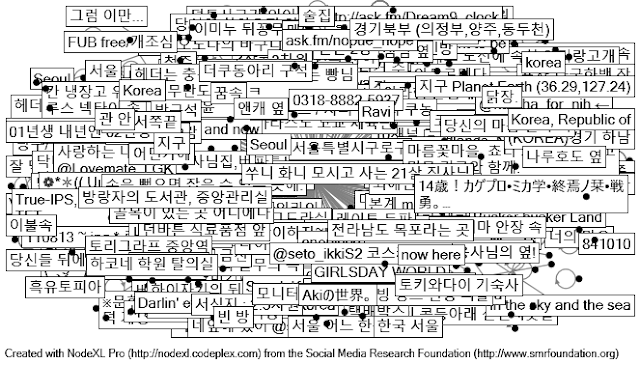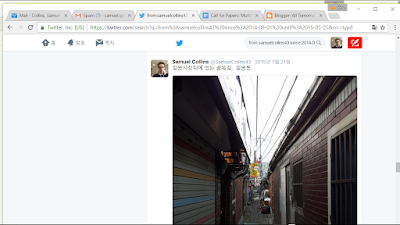-->
(the Wow! signal, visualized by Benjamin Crowell, from Wikimedia)
In a few days, many anthropologists will attend the
American Anthropological Association Annual Meeting in Washington, D.C. For several days, they will track back and
forth to airless, windowless rooms that exist in a strange non-place and
non-time: a conference space replete with kitschy designs, cheap gilding,
stentorian carpeting that suggests transit lounges and casinos at any time from
the 1970s to the 1990s. But, given the growing
horror just outside these conference-room bunkers—the growing crypto-fascism
from the authoritarian government, almost-certain ecological apocalypse,
economic and political collapse—it’s doubly important to look to the future as
the anticipation of hope, of fear and, importantly, of radical difference and
change.
And this is what has happened. This year, there are an unprecedented number
of papers and panels exploring the contours of futures in the contexts of anthropological
method and theory with the ultimate goal of working to change the present. This is clearly anthropology’s anticipatory
moment, and we see scholars from multiple subdisciplines (STS, environmental anthropology,
urban anthropology, etc.) exploring what futures might be evoked in the space
of anthropological intervention. The
methods and potentials of this are being shaped right now, and this year represents
a watershed moment.
In a way, I hope that this doesn’t coalesce into a
canonical approach to futures. The
multidirectionality of these evocations is the best feature of this round of
AAA papers: urban, multispecies, reproductive technologies, SF, dystopia,
journalism, government policy. Here the
future is multiple, and my instinct would be to contribute to open futures
through our anthropologies, rather than joining with, say, the dismal science
to close off difference through model-driven prognostications.
I have worked through the obstinate, online AAA schedule
and commented on some of the more obvious, future-oriented panels. That said, there are many, many papers that
evoke future world-making that are not in this list, but even this partial
schedule is impressive and even revolutionary (at least to anthropology). Of course, if you know of something I’ve
missed, please comment and I’ll correct my omission!
And, by the way, shame on AAA for scheduling 3 science
fiction panels at exactly the same time (2-3:45 pm on Saturday afternoon)! Three! The only good thing is that you can attend
one, and then retire to our gaming salon where you’ll find free copies of our
book, “Gaming Anthropology” and, of course, drink tickets.
(2-0150) Anthropocene Landscapes, Infrastructures and
Futures
Wednesday, November 29
12:00 PM - 1:45 PM
Location: Marriott, Marriott Ballroom Salon 2
My notes: Anthropocene brings together multiple temporal
strands around contested landscapes through ecologies, technologies,
geographies, etc. These papers consider
these multiple, future entanglements and the way they traffic between past and
present.
(2-0340) Future Cities: When, Where and How?
Wednesday, November 29
2:15 PM - 4:00 PM
Location: Marriott, Madison A
My notes: Cities are informed by developmental futures
envisioned by policy makers and technocrats, but these developmental narratives
are also open to appropriation and resistance—to other futures less yoked to
neoliberal growth.
(3-0105) Futures Come to Matter: Future as Analytic in
Ethnography
Thursday, November 30
8:00 AM - 9:45 AM
Location: Marriott, Virginia Suite C
My notes: Given that “the future” is a discursive and representational
tool for organizing the present, how might anthropologists utilize this as an “analytic”
in their ethnography?
(3-0295) Future Matters: Anticipatory Knowledge and
Scenario-modeling
Thursday, November 30
10:15 AM - 12:00 PM
My notes: In the style of Ulf Hannerz’s work in “Writing
Future Worlds” (and he’s on the panel as well), these papers consider the “anticipatory
futures” produced by various organizations in the form of “scenarios”.
(3-1035) Fabricating Utopics: Hacking Imaginaries
Thursday, November 30
4:15 PM - 6:00 PM
Location: Marriott, Thurgood Marshall North
My notes: The panel looks to appropriations of the spirit
and methods of “hacking” across a spectrum of activisms vis-à-vis the state and
the community. Hacking here refers to
subverting neo-liberal ideologies to issues of social justice and parity.
(3-1005) Future
matters: Ethnography of Weather and Climate Knowledge and Forecasting
Thursday, November 30
4:15 PM - 6:00 PM
Location: Marriott, Harding
My notes: This panel considers anthropological approaches to
“atmospheric futures” through ethnographic examinations of the various anticipatory
models people and communities produce.
(4-0180) Open and Closed Futures
Friday, December 1
8:00 AM - 9:45 AM
Location: Marriott, Roosevelt 2
My notes: These papers reflect on the “temporal turn” in
anthropology and look to different examples of “dilating” or “constricting”
through the politics of temporal practice.
(4-0810) The Other Side of Hope
Friday, December 1
2:00 PM - 3:45 PM
Location: Marriott, McKinley
My notes: Extrapolating on Miyazaki’s vision of “hope” in a
world of looming disaster, these papers consider the dystopian possibilities
that lie on the “otherside” of more hopeful multispecies and techno-imaginaries
of the future.
(4-1225) Queering Futures: Futures as Forces, Futures as
Products
Friday, December 1
4:15 PM - 6:00 PM
Location: Marriott, Roosevelt 4
My notes: Queering the future means undermining normative
(and heteronormative) visions of a future that is always already an abyssal
extension of the ideological-normative “now”.
(5-0810) “Realists” of a Larger Reality: Anthropological
intersections with Science Fiction
Saturday, December 2
2:00 PM - 3:45 PM
Location: Marriott, Virginia Suite C
My notes: This panel looks to intersections of anthropology
and science fiction, and to the ways both have been informed by contemporary
social movements. The hope is that the
confluence of all of these will open up alternatives to the fascist dystopia in
which we live.
(5-0900) Ethnography Otherwise: Imagining More-than-human
Worldings through Science Fiction
Saturday, December 2
2:00 PM - 3:45 PM
Location: Omni, Congressional A
My notes: the Anthropocene demands new tropes for describing
these complex imbrications of technology, nature, non-humans that transcend the
facile binarisms (nature v. culture) that have characterized anthropological
figurations.
These papers look to
science fiction as a source for re-figuring these relationships in
anthropological interventions.
(5-0750)
Toying with Our Teleologies: Anthropologists Read SF
Saturday, December 2 2:00 PM - 3:45 PM Location: Marriott, Thurgood Marshall West
My notes: The papers in this session look to SF as a provocation to anthropology and as a resource for its interventions. But this is a critical entanglement, and includes interrogating the politics of SF (and anthropology-in-SF).
(6-0105) Technological Futures
Sunday, December 3
8:00 AM - 9:45 AM
Location: Marriott, Delaware Suite A
My notes: this panel considers the ways technological developments
are bound up with images and practice of the future, ones that swing wildly
between utopia and dystopia.





















